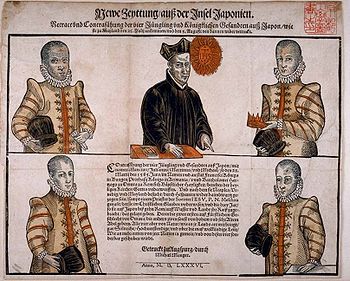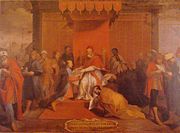
Mancio Ito
Encyclopedia


Otomo Sorin
, also known as Fujiwara no Yoshishige and Ōtomo Yoshishige , was a Japanese feudal lord of the Ōtomo clan, one of the few to have converted to Christianity. The eldest son of Ōtomo Yoshiaki, he inherited the domain of Funai, on Kyūshū, Japan's southernmost main island, from his father...
to the Pope and the kings of Europe in 1582. The embassy was led by Mancio Itō
Mancio Ito
The Tenshō embassy was an embassy sent by the Japanese Christian Lord Ōtomo Sōrin to the Pope and the kings of Europe in 1582...
(伊東 マンショ Itō Mansho, 1570–1612), a Japanese nobleman, who was the first official Japan
Japan
Japan is an island nation in East Asia. Located in the Pacific Ocean, it lies to the east of the Sea of Japan, China, North Korea, South Korea and Russia, stretching from the Sea of Okhotsk in the north to the East China Sea and Taiwan in the south...
ese emissary to Europe
Europe
Europe is, by convention, one of the world's seven continents. Comprising the westernmost peninsula of Eurasia, Europe is generally 'divided' from Asia to its east by the watershed divides of the Ural and Caucasus Mountains, the Ural River, the Caspian and Black Seas, and the waterways connecting...
.
Embassy
The idea of sending a Japanese embassy to Europe was originally conceived by the JesuitSociety of Jesus
The Society of Jesus is a Catholic male religious order that follows the teachings of the Catholic Church. The members are called Jesuits, and are also known colloquially as "God's Army" and as "The Company," these being references to founder Ignatius of Loyola's military background and a...
Alessandro Valignano
Alessandro Valignano
Alessandro Valignano, , was a Jesuit missionary born in Chieti, back then part of the Kingdom of Naples, who helped supervise the introduction of Catholicism to the Far East, and especially to Japan....
, and sponsored by the three Kirishitan
Kirishitan
, from Portuguese cristão, referred to Roman Catholic Christians in Japanese and is used as a historiographic term for Roman Catholics in Japan in the 16th and 17th centuries. Christian missionaries were known as bateren or iruman...
daimyo
Daimyo
is a generic term referring to the powerful territorial lords in pre-modern Japan who ruled most of the country from their vast, hereditary land holdings...
s Ōmura Sumitada
Omura Sumitada
Ōmura Sumitada Japanese daimyo lord of the Sengoku period. He achieved fame throughout the country for being the first of the daimyo to convert to Christianity following the arrival of the Jesuit missionaries in the mid-16th century. Following his baptism, he became known as "Dom Bartolomeu"...
(1532–1587), Ōtomo Sōrin
Otomo Sorin
, also known as Fujiwara no Yoshishige and Ōtomo Yoshishige , was a Japanese feudal lord of the Ōtomo clan, one of the few to have converted to Christianity. The eldest son of Ōtomo Yoshiaki, he inherited the domain of Funai, on Kyūshū, Japan's southernmost main island, from his father...
(1530–1587) and Arima Harunobu
Arima Harunobu
was the second son and successor of Japanese daimyo Arima Yoshisada. Harunobu was born in the castle of Arima and controlled the Shimabara area of Hizen province. After Harunobu's father's death, he began the persecution of Christians in his region. With Ryūzōji Takanobu expanding into his domain,...
(1567–1612). Mancio Itō was chosen to act as a spokesman for the group dispatched by Ōtomo Sōrin
Otomo Sorin
, also known as Fujiwara no Yoshishige and Ōtomo Yoshishige , was a Japanese feudal lord of the Ōtomo clan, one of the few to have converted to Christianity. The eldest son of Ōtomo Yoshiaki, he inherited the domain of Funai, on Kyūshū, Japan's southernmost main island, from his father...
, who was daimyō
Daimyo
is a generic term referring to the powerful territorial lords in pre-modern Japan who ruled most of the country from their vast, hereditary land holdings...
of the Bungo Province
Bungo Province
was a province of Japan in eastern Kyūshū in the area of Ōita Prefecture. It was sometimes called , with Buzen Province. Bungo bordered Buzen, Hyūga, Higo, Chikugo, and Chikuzen Provinces.-History:...
on Kyūshū
Kyushu
is the third largest island of Japan and most southwesterly of its four main islands. Its alternate ancient names include , , and . The historical regional name is referred to Kyushu and its surrounding islands....
and a close relative of Mancio's father; Shurinosuke Itō. On the 20th February 1582, Mancio Itō left Nagasaki in company with three other noblemen:
- Miguel ChijiwaMiguel Chijiwawas a member of Japanese delegate of Japan to European Christendom, Tenshō embassy. Later, he abandoned the faith. -References:...
(千々石 ミゲル Chijiwa Migeru) - Julião Nakaura (中浦 ジュリアン Nakaura Jurian)
- Martinho Hara (原 マルチノ Hara Maruchino)
They were accompanied by two servants, their tutor and interpreter Diego de Mesquita, and their mentor Valignano, who only accompanied them as far as Goa
Goa
Goa , a former Portuguese colony, is India's smallest state by area and the fourth smallest by population. Located in South West India in the region known as the Konkan, it is bounded by the state of Maharashtra to the north, and by Karnataka to the east and south, while the Arabian Sea forms its...
in India
India
India , officially the Republic of India , is a country in South Asia. It is the seventh-largest country by geographical area, the second-most populous country with over 1.2 billion people, and the most populous democracy in the world...
, where he was to take up new responsibilities. On their way to Lisbon
Lisbon
Lisbon is the capital city and largest city of Portugal with a population of 545,245 within its administrative limits on a land area of . The urban area of Lisbon extends beyond the administrative city limits with a population of 3 million on an area of , making it the 9th most populous urban...
, at which they arrived in August 1584, they spent nine months visiting Macau
Macau
Macau , also spelled Macao , is, along with Hong Kong, one of the two special administrative regions of the People's Republic of China...
, Kochi
Kochi
-Places:* Kochi, a city in the state of Kerala, India, formerly known as Cochin* Kingdom of Cochin, a former feudal city-state on Malabar Coast, India** Fort Kochi, one of the three main urban components which constitute the present day city of Kochi, Kerala, India...
and Goa
Goa
Goa , a former Portuguese colony, is India's smallest state by area and the fourth smallest by population. Located in South West India in the region known as the Konkan, it is bounded by the state of Maharashtra to the north, and by Karnataka to the east and south, while the Arabian Sea forms its...
. From Lisbon, the ambassadors went on to Rome
Rome
Rome is the capital of Italy and the country's largest and most populated city and comune, with over 2.7 million residents in . The city is located in the central-western portion of the Italian Peninsula, on the Tiber River within the Lazio region of Italy.Rome's history spans two and a half...
, which was the main goal of their journey. In Rome, Mancio Itō became an honorary citizen and taken into the ranks of European nobility with the title Cavaliere di Speron d’oro ("Knight of the Golden Spur"). During their stay in Europe, they met with King Philip II of Spain
Philip II of Spain
Philip II was King of Spain, Portugal, Naples, Sicily, and, while married to Mary I, King of England and Ireland. He was lord of the Seventeen Provinces from 1556 until 1581, holding various titles for the individual territories such as duke or count....
, Francesco I de' Medici; Grand Duke
Grand Duke
The title grand duke is used in Western Europe and particularly in Germanic countries for provincial sovereigns. Grand duke is of a protocolary rank below a king but higher than a sovereign duke. Grand duke is also the usual and established translation of grand prince in languages which do not...
of Tuscany
Tuscany
Tuscany is a region in Italy. It has an area of about 23,000 square kilometres and a population of about 3.75 million inhabitants. The regional capital is Florence ....
, Pope Gregory XIII
Pope Gregory XIII
Pope Gregory XIII , born Ugo Boncompagni, was Pope from 1572 to 1585. He is best known for commissioning and being the namesake for the Gregorian calendar, which remains the internationally-accepted civil calendar to this date.-Youth:He was born the son of Cristoforo Boncompagni and wife Angela...
and his successor Pope Sixtus V
Pope Sixtus V
Pope Sixtus V , born Felice Peretti di Montalto, was Pope from 1585 to 1590.-Early life:The chronicler Andrija Zmajević states that Felice's family originated from modern-day Montenegro...
.
The ambassadors arrived back in Japan
Japan
Japan is an island nation in East Asia. Located in the Pacific Ocean, it lies to the east of the Sea of Japan, China, North Korea, South Korea and Russia, stretching from the Sea of Okhotsk in the north to the East China Sea and Taiwan in the south...
on 21 July 1590. On their eight year long voyage they had been instructed to take notes. These notes provided the basis for the De Missione Legatorum Iaponensium ad Romanam Curiam ("The Mission of the Japanese Legates to the Roman Curia
Roman Curia
The Roman Curia is the administrative apparatus of the Holy See and the central governing body of the entire Catholic Church, together with the Pope...
"), a Macau
Macau
Macau , also spelled Macao , is, along with Hong Kong, one of the two special administrative regions of the People's Republic of China...
-based writing by Jesuit Duarte de Sande published in 1590.
The four were subsequently ordained as the first ever Japanese Jesuit fathers by Alessandro Valignano.
Mancio Itō died in Nagasaki on November 13, 1612.
Martinho Hara was banished from Japan by the Tokugawa Shogunate
Tokugawa shogunate
The Tokugawa shogunate, also known as the and the , was a feudal regime of Japan established by Tokugawa Ieyasu and ruled by the shoguns of the Tokugawa family. This period is known as the Edo period and gets its name from the capital city, Edo, which is now called Tokyo, after the name was...
in 1614, and acted in Macau
Macau
Macau , also spelled Macao , is, along with Hong Kong, one of the two special administrative regions of the People's Republic of China...
. He died in Macau on October 23, 1629.
Miguel Chijiwa seceded Society of Jesus
Society of Jesus
The Society of Jesus is a Catholic male religious order that follows the teachings of the Catholic Church. The members are called Jesuits, and are also known colloquially as "God's Army" and as "The Company," these being references to founder Ignatius of Loyola's military background and a...
before 1601, and died in Nagasaki on January 23, 1633. The reason of his secession is uncertain.
Julião Nakaura was caught by the Tokugawa Shogunate, and died a martyr by torture in Nagasaki on November 21, 1633. He was beatified on November 24, 2008.
See also
- Bernardo, the Japanese, the first Japanese to visit Europe, in 1553.
- Hasekura TsunenagaHasekura TsunenagaHasekura Rokuemon Tsunenaga or was a Japanese samurai and retainer of Date Masamune, the daimyo of Sendai....
, another Japanese embassy to Europe in 1615.

